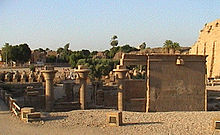Hakor
| Hakor | |||||||||||||||||||||||||||||||||||||||||||||||||||||||||||||||||||||||||||||||||||||||||||||||||||||||||||||||||||||
|---|---|---|---|---|---|---|---|---|---|---|---|---|---|---|---|---|---|---|---|---|---|---|---|---|---|---|---|---|---|---|---|---|---|---|---|---|---|---|---|---|---|---|---|---|---|---|---|---|---|---|---|---|---|---|---|---|---|---|---|---|---|---|---|---|---|---|---|---|---|---|---|---|---|---|---|---|---|---|---|---|---|---|---|---|---|---|---|---|---|---|---|---|---|---|---|---|---|---|---|---|---|---|---|---|---|---|---|---|---|---|---|---|---|---|---|---|---|
| Achoris, Hakoris, Hagar | |||||||||||||||||||||||||||||||||||||||||||||||||||||||||||||||||||||||||||||||||||||||||||||||||||||||||||||||||||||
 Upper half of statue of Hakor. In Cairo Museum | |||||||||||||||||||||||||||||||||||||||||||||||||||||||||||||||||||||||||||||||||||||||||||||||||||||||||||||||||||||
| Pharaoh | |||||||||||||||||||||||||||||||||||||||||||||||||||||||||||||||||||||||||||||||||||||||||||||||||||||||||||||||||||||
| Reign | 392/1–379/8 BCE[1][2] | ||||||||||||||||||||||||||||||||||||||||||||||||||||||||||||||||||||||||||||||||||||||||||||||||||||||||||||||||||||
| Predecessor | Nepherites I(392/1 BCE); Psammuthes(390/89 BCE) | ||||||||||||||||||||||||||||||||||||||||||||||||||||||||||||||||||||||||||||||||||||||||||||||||||||||||||||||||||||
| Successor | Psammuthes (391/0 BCE); Nepherites II(379/8 BCE) | ||||||||||||||||||||||||||||||||||||||||||||||||||||||||||||||||||||||||||||||||||||||||||||||||||||||||||||||||||||
| |||||||||||||||||||||||||||||||||||||||||||||||||||||||||||||||||||||||||||||||||||||||||||||||||||||||||||||||||||||
| Children | Nepherites II | ||||||||||||||||||||||||||||||||||||||||||||||||||||||||||||||||||||||||||||||||||||||||||||||||||||||||||||||||||||
| Father | Nepherites I? | ||||||||||||||||||||||||||||||||||||||||||||||||||||||||||||||||||||||||||||||||||||||||||||||||||||||||||||||||||||
| Dynasty | 29th Dynasty | ||||||||||||||||||||||||||||||||||||||||||||||||||||||||||||||||||||||||||||||||||||||||||||||||||||||||||||||||||||
HakororHagar,[3]also known by thehellenizedformsAchorisorHakoris,was anancient Egyptianpharaohof the29th Dynasty.His reign marks the apex of this feeble and short-lived dynasty, having ruled for 13 years – more than half of its entire duration.[4]
Reign
[edit]Struggle for the accession
[edit]Hakor's accession and relationships with his predecessorNepherites Iwere long debated. After Nepherites' death a dynastic struggle did seem to have occurred,[5]and the throne was claimed by two or maybe three pretenders: Hakor,Psammuthes,and possibly a phantom figure calledMuthiswho was only mentioned inEusebius' epitome ofManetho'sAegyptiaca.As a result, Hakor was alternately considered Nepherites' legitimate successor or an unrelatedusurper.
In 1986,John D. Raysuggested that Hakor was Nepherites' heir, who ruled undisturbed until his Year 2 when he was deposed by Psammuthes. After another year, Hakor managed to retake his legitimate throne by overthrowing the usurper, and continued to date his reign since his first coronation date, simply pretending that this gap never occurred. The third pretender, Muthis, could be inserted within this struggle, but his role – assuming that he really did exist – is unknown.[6]Ray's hypothesis is accepted by otherEgyptologistssuch as Alan B. Lloyd[7]andToby Wilkinson.[3]
Shortly after his death, Hakor was called an usurper by the founder of the subsequent dynasty,Nectanebo I.However, it has been suggested that Hakor and Nectanebo might have been relatives in some way, possibly both related to Nepherites I but rivals to each other.[5]
Activities in Egypt
[edit]
Once re-established, Hakor made considerable exertions to affirm his legitimacy,[4]putting emphasis on his – real or fictional – descent from Nepherites.[5][8]His building activity was remarkable and he also extensively restored many monuments of his royal predecessors.[8]
InKarnak,Hakor finished the chapel for the sacred barque ofAmun-Ranear the first pylon which was started by Psammuthes or possibly by Nepherites I;[9]he also possibly began a temple complex in northernSaqqarawhich was later further developed underNectanebo II.[10]His building activity is well attested in various places inUpper Egypt(Luxor,Medinet Habu,El-Kab,El-Tod,Medamud,Elephantine), in theTemple of HibisofKharga Oasis,as well as other locations inMiddle Egypt.[11]
Foreign relations
[edit]Hakor apparently reprised Nepherites' foreign policy. InAristophanes' comedyPlutus,which was performed in 388 BCE, an alliance between the Athenians and the Egyptians is mentioned, though it was more likely intended to refer to the Athenian support for the rebellion ofEvagoras I of Cyprus– himself allied with Hakor – against theAchaemenids.Theopompusalso reported an alliance between Hakor and thePisidians.Thepeace of Antalcidasbetween the Persians and Greeks (387 BCE) was a turning point: after that, Egypt andCyprusremained the only opponents ofArtaxerxes IIas reported by Theopompus andOrosius.The following years are quite obscure, but it seems that the Persians first attacked Egypt in 385 BCE and, after three years of war, the Egyptians managed to defeat the invaders;[12][13][14]The AthenianrhetoricianIsocratesmentioned this war vaguely and disparagingly.[15]
In 381 BCE, Hakor sent aid, money and 50triremes(apparently without crew, though) to Evagoras in order to contribute to his resistance against the Great King who, after the unsuccessful campaign in Egypt, was now focusing on Cyprus. However, when, in 380 BCE, Evagoras travelled to Egypt to beg for further aid, Hakor saw no need to continue supporting him and sent him back to Cyprus with merely some more money.[16][17]Evagoras surrendered to Artaxerxes soon after, but Hakor promptly joined a short-lived alliance with Sparta and with Glos, son of theEgyptian admiral, Tamos,who was a supporter of the pretenderCyrus the Youngeragainst Artaxerxes II. Hakor managed to get the Athenian generalChabriasinto his service, but the Persian generalPharnabazus IIlobbied Athens seeking for them to repatriate him.[16]
Death and succession
[edit]Hakor died in 379/8 BCE,[2]leaving his throne to his sonNepherites II.However, the latter was able to keep it for just four months before being overthrown and replaced by an army general fromSebennytos,Nectanebo I.[3]
References
[edit]- ^Lloyd 1994,p. 358.
- ^abDepuydt 2006,p. 280.
- ^abcWilkinson 2010,p. 456.
- ^abLloyd 1994,p. 340.
- ^abcGrimal 1992,p. 373.
- ^Ray 1986,pp. 149–158.
- ^Lloyd 1994,p. 357.
- ^abClayton 1994,p. 203.
- ^Lloyd 1994,p. 353.
- ^Lloyd 1994,p. 354.
- ^Grimal 1992,p. 374.
- ^Lloyd 1994,p. 347.
- ^Grimal 1992,pp. 374–375.
- ^Fine 1983,p. 358.
- ^Gardiner 1961,p. 374.
- ^abLloyd 1994,p. 348.
- ^Grimal 1992,p. 375.
Bibliography
[edit]- Clayton, Peter (1994).Chronicle of the Pharaohs.London: Thames & Hudson Ltd.ISBN9780500050743.
- Depuydt, Leo (2006). "Saite and Persian Egypt, 664 BC - 332 BC". In Hornung, Erik; Krauss, Rolf; Warburton, David A. (eds.).Ancient Egyptian Chronology.Brill, Leiden/Boston. pp. 265–283.ISBN978-90-04-11385-5.
- Fine, John V. A. (1983).The Ancient Greeks: A critical history.Harvard University Press.
- Gardiner, Alan H.(1961).Egypt of the Pharaohs: an introduction.Oxford: Oxford University press.
- Grimal, Nicolas(1992).A History of Ancient Egypt.Oxford: Blackwell Books. p. 512.ISBN9780631174721.
- Lloyd, Alan B. (1994). "Egypt, 404–322 B.C.". In Lewis, D.M.; Boardman, John; Hornblower, Simon; et al. (eds.).The Cambridge Ancient History (2nd ed.), vol. VI – The Fourth Century B.C.Cambridge University Press. pp. 337–360.ISBN0-521-23348-8.
- Ray, John D.(1986). "Psammuthis and Hakoris".The Journal of Egyptian Archaeology.72:149–158.doi:10.1177/030751338607200112.S2CID192348366.
- Wilkinson, Toby(2010).The Rise and Fall of Ancient Egypt.London: Bloomsbury. p. 672.ISBN978-1-4088-10026.
External links
[edit]- "166 Antonius Diogenes, The incredible wonders beyond Thule".Photius: Bibliotheca.tertullian.org.

